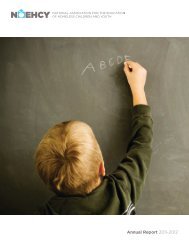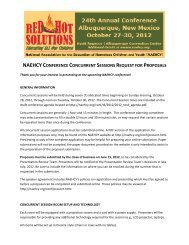The McKinney-Vento Act and Children and Youth ... - State of Michigan
The McKinney-Vento Act and Children and Youth ... - State of Michigan
The McKinney-Vento Act and Children and Youth ... - State of Michigan
You also want an ePaper? Increase the reach of your titles
YUMPU automatically turns print PDFs into web optimized ePapers that Google loves.
they will be better able to manage the dem<strong>and</strong>s <strong>of</strong> foster care <strong>and</strong> to behave<br />
appropriately in the home environment. This can include efforts by educators<br />
to provide specific supports to the foster care families <strong>and</strong> caretakers who are<br />
supporting the youth at home.<br />
<strong>The</strong> <strong>McKinney</strong>-<strong>Vento</strong> <strong>Act</strong> gives students who are awaiting foster placement<br />
the right to remain in their school <strong>of</strong> origin, despite placement changes, if<br />
in their best interest. <strong>The</strong> <strong>Act</strong> further requires school districts to provide<br />
transportation to the school <strong>of</strong> origin. This transportation is absolutely<br />
essential to ensure school stability <strong>and</strong> promote the educational success <strong>of</strong> all<br />
homeless children <strong>and</strong> youth. However, it entails a significant expense <strong>and</strong><br />
logistical challenge for school districts. Shortages <strong>of</strong> buses, drivers, <strong>and</strong> taxis<br />
as well as severe budget crises threaten the ability to provide transportation.<br />
Cooperation between<br />
education <strong>and</strong> child welfare<br />
agencies is essential to<br />
ensure that the expense<br />
<strong>and</strong> logistical challenges <strong>of</strong><br />
transportation do not pose a<br />
barrier to services <strong>and</strong> that<br />
transportation is provided<br />
quickly <strong>and</strong> efficiently for all<br />
students.<br />
Some <strong>of</strong> the states <strong>and</strong> localities interviewed for this publication have<br />
developed strategies to confront the financial <strong>and</strong> logistical challenges <strong>of</strong><br />
transportation. Many have secured supplemental funding for transportation.<br />
Such funding has been obtained through appropriations from the state<br />
legislature as well as through outside grants. Obtaining increased funding for<br />
transportation has been absolutely critical, as there simply are not enough<br />
resources to provide transportation to all eligible students at the current<br />
<strong>McKinney</strong>-<strong>Vento</strong> funding level.<br />
STRATEGY<br />
<strong>The</strong> state bears the<br />
cost <strong>of</strong> school-<strong>of</strong>-origin<br />
transportation.<br />
WHERE PRACTICED<br />
Delaware<br />
<strong>The</strong> child welfare agency<br />
pays for commutes that<br />
are particularly long,<br />
complex, or costly, on a<br />
case-by-case basis. In<br />
Virginia, to increase the<br />
agency’s capacity to bear<br />
this cost, in 2007 the<br />
state legislature allocated<br />
$150,000 for school-<strong>of</strong>origin<br />
transportation for<br />
youth in out-<strong>of</strong>-home care.<br />
Ann Arbor, MI<br />
Fairfax County, VA<br />
Strategies for Improving Educational Outcomes through School Stability 35














